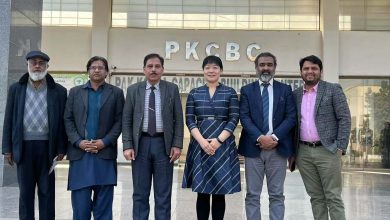China gearing up to take on pharmaceutical giants, drive biotech boom: innovator
The company is not alone, with China now home to more than 10,000 sizeable pharmaceutical enterprises researching the second-highest number of new medicines in the world, according to the industry and information technology ministry.
Recent years have seen a significant boost in China’s investment in pharmaceutical R&D– from government and companies – driven by concerns that the US – long the biotechnology leader – could expand its technology sanctions to include essential medicines.
China targets hi-tech drug and medical equipment industries for support
China targets hi-tech drug and medical equipment industries for support
“Chinese researchers are now in the arena of innovative drug research and development. Just like in hi-tech industries, the involvement of Chinese people could bring disruption,” Wang said.
This disruption could expand and hasten the delivery of innovative medications previously available only in developed countries to 4 billion people or more, he added.
Wang was attending the forum as a laureate of the Shaw Prize, established in 2002 by the late Hong Kong philanthropist Sir Run Run Shaw to honour individuals from around the world for their outstanding contributions to civilisation.
Wang was awarded the Shaw Prize in 2006 for his discovery of the biochemical basis of programmed cell death, which balances cellular generation and forms the body’s defence against cancer.
Thanks to Wang’s discovery, pharmaceutical companies are developing treatments designed to mimic the mitochondrial death-inducers to overcome tumorous cells and eliminate cancer.
Limits on China biotech and AI next after semiconductor curbs: US official
Limits on China biotech and AI next after semiconductor curbs: US official
Wang, who was born in the central Chinese city of Wuhan, received his PhD in biochemistry in 1991 from the University of Texas Southwestern Medical Centre after graduating from Beijing Normal University.
Wang’s career began in Atlanta, with the Emory University School of Medicine’s biochemistry department. In 2004, he was elected a member of the US National Academy of Sciences – one of the country’s highest science honours.
Wang – a foreign associate of the Chinese Academy of Sciences since 2013 and the founding director of the National Institute of Biological Sciences in Beijing – said the race for novel medicines lies beyond countries and instead is between humankind and diseases.
How China could use its rare disease burden to its ‘advantage’
How China could use its rare disease burden to its ‘advantage’
“Science, especially basic research, is a matter for humankind. Despite competition among pharmaceutical companies, patents last up to 20 years and the products will eventually benefit the younger generation,” he said.
“Innovative drug R&D is certainly global-facing. Novel drugs are either first-in-class for a disease without existing treatment, or best-in-class to produce higher quality medicines. Both should bring global benefits.”
An analysis published by the journal Nature in January concluded that most Chinese pharmaceutical companies are still in the early stages of innovative drug research, with only Wang’s BeiGene and the firm Innovent Biologics matching their multinational competitors in the development of novel targets or mechanisms.
The study – by researchers from Fudan University’s School of Pharmacy, the Shanghai Centre for Drug Discovery and Development, and the Tufts Centre for the Study of Drug Development in Boston – compared R&D pipelines from China’s top 20 pharmaceutical companies and 20 non-Chinese multinational ones.
As research grants in US hit 25-year low, China plans for exponential growth
As research grants in US hit 25-year low, China plans for exponential growth
They found that many of the latter had more than 15 products approved between 2012 and 2021, while Chinese companies had less than five. Over the same 10-year period, 31 medicines were brought to market in China, compared to 313 overseas.
The researchers noted that innovation has been a top priority for China’s pharmaceutical industry in the past decade, driven by new and complex medical needs, rapid market expansion and regulatory system reform.
“To compete on the global stage, continuous investment, consolidation and structural changes to improve efficiency are important potential solutions,” they said.
A report by consulting firm McKinsey in August last year said the number of innovative assets under clinical development in China had tripled in the past five years, even though Chinese companies remained focused on continual development rather than first-in-class innovation.
China’s life science property sector boosted by rising demand for lab space
China’s life science property sector boosted by rising demand for lab space
The report noted that China has created a conducive environment for biotechnology and pharmaceutical companies to develop medicines and stimulate the market through research, clinical development and manufacturing.
Speaking last week at a conference on the development of China’s pharmaceutical sector, industry and information technology minister Jin Zhuanglong said average annual growth in R&D investment has exceeded 20 per cent since 2021, delivering innovative treatments and high-end medical devices.
Jin said the government encourages multinational pharmaceutical companies to set up R&D centres and innovative production bases in China, while supporting domestic enterprises in importing advanced foreign technologies and products.
“[We] encourage enterprises to seek international certification, accelerate the pace for vaccines, innovative drugs, high-end pharmaceutical preparation and medical devices to go global, and actively take part in international industrial division of labour and cooperation,” he said.
Beijing bets on biotech to boost China’s foreign investment inflows
Beijing bets on biotech to boost China’s foreign investment inflows
Last month, a treatment based on the PD-1 receptor in the immune system’s T-cells became the first Chinese biopharmaceutical cancer medicine to be approved for the US market.
Toripalimab, developed by Shanghai Junshi Biosciences, is designed to bind to the PD-1 receptor, blocking attacks from malignant tumour cells and allowing the immune system to do its job and kill the tumours.
According to an analysis published last year by the journal Nature, China had 37 PD-1 based monoclonal antibody treatments in the pipeline, part of a group of oncology treatments that share the same targets as already-approved medicines.
Chinese cancer drug makes historic foray into US amid medicine crisis
Chinese cancer drug makes historic foray into US amid medicine crisis
The researchers, from the Tsinghua Clinical Research Institute and pharmaceutical data intelligence platform PharmCube, said “the vibrant landscape of innovative drug candidates in China is increasingly leading to marketed products”.
The study also noted that “the impact globally of such agents is anticipated to increase.”
Back on the sidelines of the Hong Kong forum, Wang said that, in addition to PD-1 inhibitors, Chinese companies are expanding their scope to produce gene therapies, cell-based therapies and antibody-drug conjugates to deliver chemotherapy agents directly into cancer cells.
“China has already caught up [with the West]. As long as a product is available overseas, Chinese companies will produce even more.”
Chinese scientists create wireless charger that can stay in human body
Chinese scientists create wireless charger that can stay in human body
The rise of out-licensing deals – which grant foreign companies the right to use products developed in China – shows the high recognition overseas for innovative Chinese medicines and technology, Wang said.
“Out-licensing deals outnumbering in-licensing ones is a key indicator that the level and scale of domestic novel drug R&D have reached a turning point. It was unimaginable a few years ago but out-licensing will become even more common in the future.”
According to Wang, Chinese companies will also be looking for other ways to reach overseas markets, such as co-promotion, where two firms promote a product under one name.
Chinese scientists use AI to develop groundbreaking drug
Chinese scientists use AI to develop groundbreaking drug
Wang said that the Chinese research community should move away from the mindset shaped by traditional cultural values, which emphasise respect for seniors and obedience, if scientific development in China is to maintain its momentum.
“Some traditional values are not compatible with principles of scientific inquiry. The elderly are seen as an authority in Chinese culture, but science is a breakthrough culture where perceptions are challenged,” he said.
“It is tremendously difficult to tackle challenges facing the whole of mankind. It is best to leave it to passionate, young and fearless scientists.”





